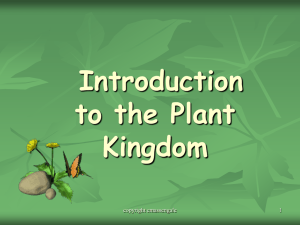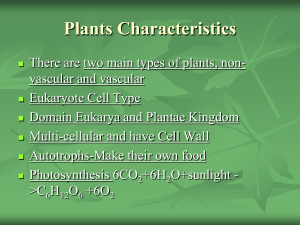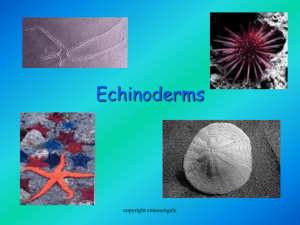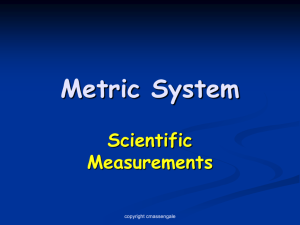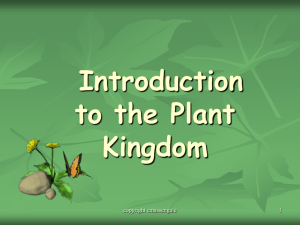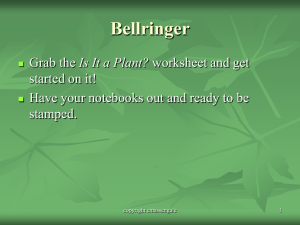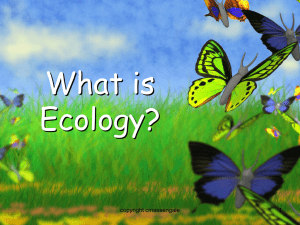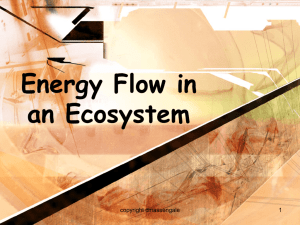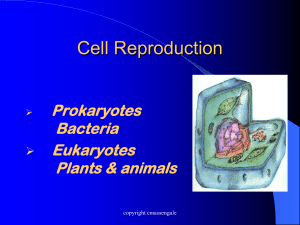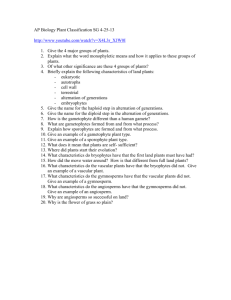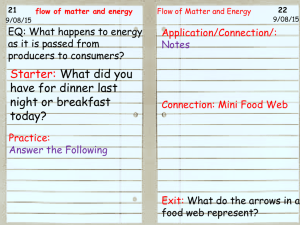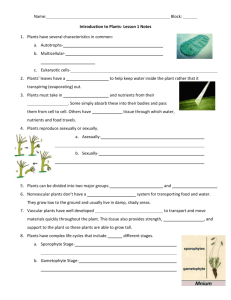Intro to plants
advertisement
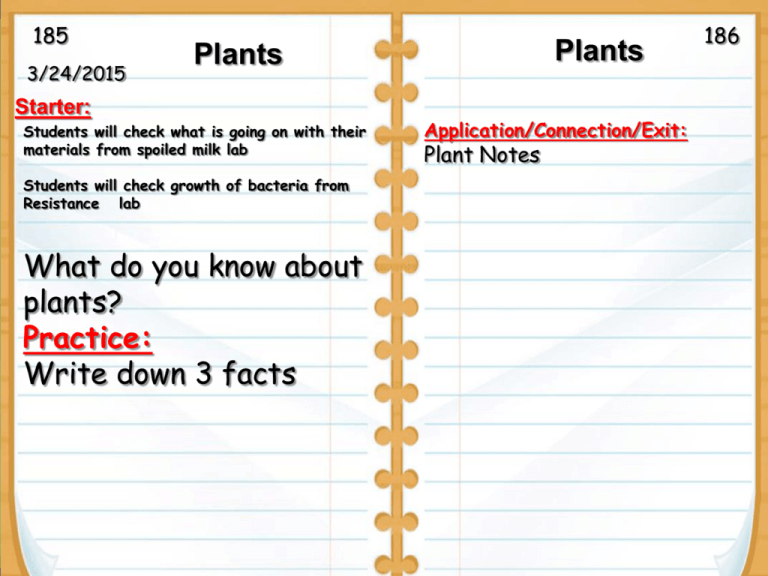
185 3/24/2015 Plants Plants Starter: Students will check what is going on with their materials from spoiled milk lab Students will check growth of bacteria from Resistance lab What do you know about plants? Practice: Write down 3 facts Application/Connection/Exit: Plant Notes 186 March 23, 2015 AGENDA B. 8 A B.10B Describe the interactions that occur among systems that perform the functions of transport, reproduction, and response in plants. 1 Starter 2. Notes Table of Contents Date Lecture/ Activity/ Lab 2/12 Ordering Fossils Activity 2/13 Evidence of Fossils 2/17 Test Review 2/19-20 Classification 2/23 Dichotomous Key Notes 2/24 Dichotomous Key Project 3/5 Cladagrams 3/16 Bacteria, Viruses, and Protista 3/17 Virus lab 3/18 Virus Model 3/19 Bacteria Lab 3/23 Antibiotic Resistance Lab 3/26 Intro to plants Page 161-162 163-164 165-166 167-168 169-170 171-172 173-174 175-176 177-178 179-180 181-182 183-184 185-186 Introduction to the Plant Kingdom copyright cmassengale 4 Early Ancestors Aquatic to Terrestrial Life copyright cmassengale 5 Aquatic Ancestor Closest living species to a possible land plant ancestor Group of green algae Called Charyophyceans copyright cmassengale Chara 6 Algae & Land Plant Similarities Both contain chlorophylls a and b Have chloroplasts with stacks of thylakoids Store starch in plastids Cellulose in cell walls Go through Alternation of Generations life Cycle copyright cmassengale 7 Aquatic Habitat Terrestrial Habitat copyright cmassengale 8 Living in Aquatic Environments Plants surrounded by water so don’t dry out Sperm swims to egg Water supports plant Plants stay in upper surface near light Absorb nutrients from the H2O copyright cmassengale 9 Plant Adaptations to Land Problems: Need minerals Gravity Increase in Height for Light Adaptations for Drier environment Reproduction Solutions: Roots absorb H2O & minerals Lignin & cellulose in cell walls Vascular Transport System Waxy cuticle & stomata with guard cells Pollen containing sperm copyright cmassengale 10 How Are Plants All Alike? copyright cmassengale 11 Plant Characteristics Multicellular Autotrophic (photosynthesis) Chlorophylls a and b in thylakoid membranes Surrounded by cell walls containing cellulose (polysaccharide) Store reserve food as amylose (starch) copyright cmassengale 12 Plant Reproduction Alternation of generations life cycle Diploid (2n) sporophyte stage Haploid (1n) gametophyte stage Produce multicellular embryo protected inside multicellular haploid (gametophyte egg sac) tissue copyright cmassengale 13 Plant Reproduction Diploid (2n) sporophyte stage produces haploid spores by meiosis Haploid spores undergo mitosis to produce gametophyte stage Gametophyte makes gametes (eggs and sperm) by meiosis Zygote (2n) produces the new sporophyte copyright cmassengale 14 Alternation of Generations Gametophyte 2n Sporophyte 2n gametophyte 1n pollen 2n seed with plant embryo Sporophyte Ovary with 1n ovules (eggs) copyright cmassengale 15 Plant Divisions copyright cmassengale 16 Taxonomy Plants are divided into two groups Based on the presence or absence of an internal transport system for water and dissolved materials Called Vascular System Vascular Bundles copyright cmassengale 17 Vascular System Xylem tissue carries water and minerals upward from the roots Phloem tissue carries sugars made by photosynthesis from the leaves to where they will be stored or used Sap is the fluid carried inside the xylem or phloem copyright cmassengale 18 Nonvascular Plants Do not have vascular tissue for support or conduction of materials Called Bryophytes Require a constantly moist environment Sporophyte stage Gametophyte Stage Moss Gametophytes & copyright cmassengale Sporophytes 19 Nonvascular Plants Plants can’t grow as tall Cells must be in direct contact with moisture Materials move by diffusion cell-to-cell Sperm must swim to egg through water droplets copyright cmassengale 20 Nonvascular Plants Includes mosses (Bryophyta), liverworts (Hepatophyta), and hornworts (Antherophyta) Liverworts copyright cmassengale Hornworts 21 Main Parts of Vascular Plants Shoots -Found above ground -Have leaves attached - Photosynthetic part of plant Roots -Found below ground -Absorb water & minerals -Anchor the plant copyright cmassengale 22 Vascular Plants Also called Tracheophytes Subdivided into two groups -Seedless vascular plants and Seedbearing vascular plants copyright cmassengale Club Moss 23 Seedless Vascular Plants Includes club moss (Lycophyta), horsetails (Sphenophyta), whisk ferns (Psilophyta), and ferns (Pterophyta) Whisk ferns copyright cmassengale Horsetails 24 Seed-Producing Vascular Plants Includes two groups – Gymnosperms and Angiosperms Gymnosperms have naked seeds in cones Angiosperms have flowers that produce seeds to attract pollinators and produce seeds copyright cmassengale 25 Gymnosperms Coniferophyta are known as conifers Includes pine, cedar, spruce, and fir Cycadophyta – cycads Ginkgophyta ginkgo Cycad Ginkgo copyright cmassengale 26 Gymnosperms Contains the oldest living plant – Bristle cone pine Contains the tallest living plant – Sequoia or redwood copyright cmassengale 27 Angiosperms Flowering plants Seeds are formed when an egg or ovule is fertilized by pollen in the ovary Ovary is within a flower Flower contains the male (stamen) and/or female (ovaries) parts of the plant Fruits are frequently produced from these ripened ovaries (help disperse seeds) copyright cmassengale 28 Angiosperms Division Anthophyta Subdivided into two groups – Monocots and Dicots Monocots have a single seed cotyledon Dicots have two seed cotyledons copyright cmassengale 29 Monocots Parallel venation in leaves Flower parts in multiples of 3 Vascular tissue scattered in cross section of stem copyright cmassengale 30 Dicots Net venation in leaves Flower parts in multiples of 4 or 5 Vascular tissue in rings in cross section of stem copyright cmassengale 31 185 3/24/2015 Plants Plants Starter: Students will check what is going on with their materials from spoiled milk lab Students will check growth of bacteria from Resistance lab What do you know about plants? Practice: Write down 3 facts Application/Connection/Exit: Plant Notes 186
